【Encyclopedia of Chinese Herbal Medicine】 Here we have selected the top ten famous TCM formulas, organized into two parts for your reading and collection. The top ten formulas include Xiao Qing Long Tang (Minor Blue Dragon Decoction) from “Shang Han Lun (Treatise on Cold Damage)”, Da Cheng Qi Tang (Major Order the Qi Decoction) from “Shang Han Lun”, Xiao Chai Hu Tang (Minor Bupleurum Decoction) from “Shang Han Lun”, Wu Ling San (Five-Ingredient Powder with Poria) from “Shang Han Lun”, Xiao Yao San (Free and Easy Wanderer Powder) from “Tai Ping Hui Min He Ji Ju Fang (Formulas for the People’s Welfare)”, Xue Fu Zhu Yu Tang (Blood Mansion Drive Out Stasis Decoction) from “Yi Lin Gai Cuo (Corrections in Medical Forest)”, Bu Zhong Yi Qi Tang (Tonify the Middle and Augment the Qi Decoction) from “Pi Wei Lun (Treatise on the Spleen and Stomach)”, Gui Pi Tang (Return the Spleen Decoction) from “Ji Sheng Fang (Formulas for Life Preservation)”, Liu Wei Di Huang Wan (Six-Ingredient Pill with Rehmannia) from “Xiao Er Yao Zheng Zhi Jue (Directives for Pediatric Medicine)”, and Wen Dan Tang (Warm the Gallbladder Decoction) from “San Yin Ji Yi Bing Zheng Fang Lun (Discussion on the Patterns of Three Causes and One Disease)”).
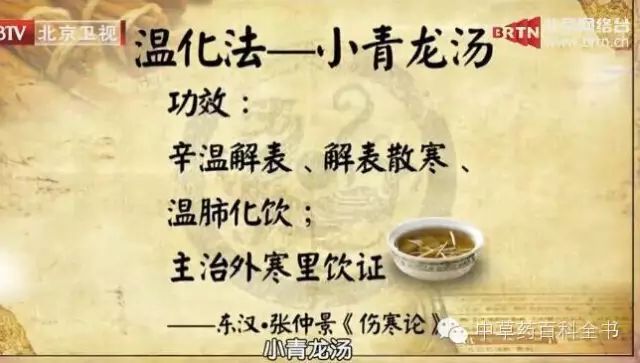 1、Xiao Qing Long Tang (Minor Blue Dragon Decoction)《Shang Han Lun》
1、Xiao Qing Long Tang (Minor Blue Dragon Decoction)《Shang Han Lun》
Composition: Ma Huang (Ephedra) 9g, Gui Zhi (Cinnamon Twig) 9g, Gan Jiang (Dried Ginger) 9g, Xi Xin (Asarum) 3g, Wu Wei Zi (Schisandra) 6g, Bai Shao (White Peony) 9g, Ban Xia (Pinellia) 12g, Gan Cao (Licorice) 6g.
Usage: Decoction in water, divided into two doses.
Function: Releases the exterior, disperses cold, warms the lungs, and transforms phlegm.
Indications: External contraction of wind-cold with internal accumulation of water and phlegm. Symptoms include aversion to cold, fever, no sweating, cough with copious white thin phlegm, and in severe cases, wheezing and inability to lie down, or swelling of limbs and face, no thirst, thin white and moist tongue coating, and floating tight pulse.
Formula Analysis: This formula is for releasing the exterior and clearing phlegm. When there is internal water accumulation, once exposed to external cold, it causes exterior cold to provoke internal phlegm. Water cold attacks the lungs, leading to cough with thin phlegm, wheezing, and fullness in the chest, and in severe cases, inability to lie flat. Therefore, the internal phlegm and external pathogen must be resolved, and the internal phlegm must be transformed.
In this formula, Ma Huang is the main herb for inducing sweating, releasing the exterior, and promoting lung function to move water. Gui Zhi assists Ma Huang in releasing the exterior and can also warm and transform Yang Qi, aiding Ma Huang in moving water as an adjunct herb. Bai Shao harmonizes the nutritive and defensive Qi with Gui Zhi. Gan Jiang and Xi Xin warm the cold of the spleen and lungs, allowing the spleen to disperse essence, which ascends to the lungs, enabling the lungs to regulate the water pathways and drain to the bladder, thus allowing the fluids to circulate normally in the body, preventing the source of phlegm; Ban Xia dries and transforms phlegm, treating already formed water and phlegm; Wu Wei Zi astringes the lungs and stops cough, preventing excessive depletion of lung Qi. All of these are adjunct herbs. Gan Cao harmonizes the various herbs, moderating the harsh and warming nature of Ma Huang, Gui Zhi, and Gan Jiang. Together, these herbs achieve the functions of releasing the exterior, clearing phlegm, stopping cough, and calming wheezing.
Precautions: Gan Jiang, Xi Xin, Ban Xia, and Wu Wei Zi are essential herbs for treating cough, wheezing, and phlegm. If the lung cold and water accumulation is predominant, the dosage of Wu Wei Zi should be less than that of Gan Jiang and Xi Xin; if the cough due to cold phlegm is from lung deficiency, the dosage of Wu Wei Zi should be increased appropriately.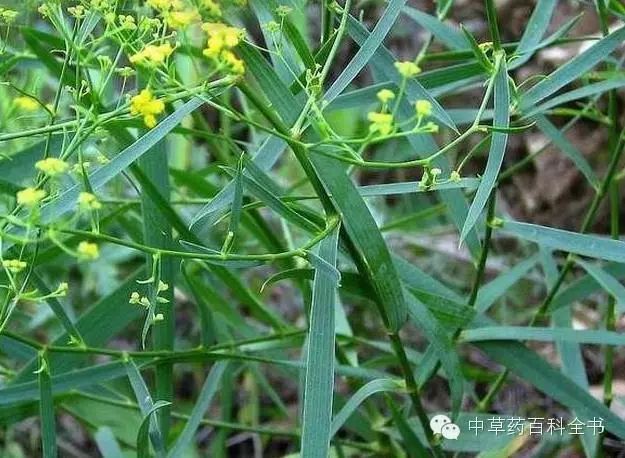
2、Xiao Chai Hu Tang (Minor Bupleurum Decoction)《Shang Han Lun》
Composition: Chai Hu (Bupleurum) 9g, Huang Qin (Scutellaria) 9g, Zhi Ban Xia (Prepared Pinellia) 6g, Zhi Gan Cao (Honey-Fried Licorice) 3g, Sheng Jiang (Fresh Ginger) 3 slices, Da Zao (Jujube) 3 pieces, Dang Shen (Codonopsis) 6g.
Usage: Decoction in water.
Function: Harmonizes and resolves the exterior and interior, supports the righteous Qi and expels evil.
Indications: For Shao Yang syndrome with alternating chills and fever, fullness and pain in the chest and flanks, lack of desire to eat, irritability, nausea, bitter mouth, dry throat, tinnitus, and thin white tongue coating with wiry and rapid pulse.
Formula Analysis: When the pathogen is in the exterior, sweating is appropriate; when it is in the interior, purging is appropriate. However, in Shao Yang disease, the pathogen is between the exterior and interior, so neither sweating nor purging is appropriate. Therefore, Chai Hu is used to disperse the Shao Yang pathogen, while Huang Qin drains the heat from the half interior. These two herbs work together to resolve the alternating chills and fever, fullness in the chest and flanks, and irritability. Ban Xia and Sheng Jiang are added to harmonize the stomach and stop nausea; Dang Shen, Gan Cao, and Da Zao tonify Qi, support the righteous Qi, and expel evil, while ginger and dates work together to harmonize the nutritive and defensive Qi.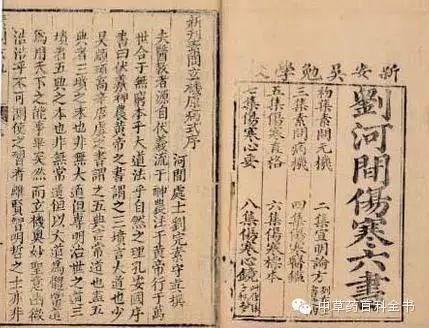
3、Da Cheng Qi Tang (Major Order the Qi Decoction)《Shang Han Lun》
Composition: Da Huang (Rhubarb) 12g, Hou Po (Magnolia Bark) 9g, Zhi Shi (Bitter Orange) 9g, Mang Xiao (Glauber’s Salt) 12g.
Usage: Decoction in water.
Function: Harshly purges heat accumulation.
Indications: (1) Dry heat accumulation in the intestines and stomach. Symptoms include hard and dry stools, abdominal distension and pain, high fever, delirium, tongue coating that is dry and yellow with prickles, and a deep, forceful pulse. (2) Heat accumulation with diarrhea. Symptoms include watery diarrhea with foul odor, and despite diarrhea, abdominal distension and pain do not lessen, with a firm and painful abdomen, dry mouth and tongue, and a slippery and rapid pulse.
Formula Analysis: This formula is a harsh purgative that has the function of unblocking the bowels and purging heat. The main herb, Da Huang, is bitter and cold, purging heat and unblocking the bowels, and clearing the intestines and stomach; Mang Xiao is salty and cold, purging heat and softening hardness; if the accumulation does not resolve, it is due to Qi stagnation, so Zhi Shi and Hou Po are added to eliminate fullness and distension, move Qi, and disperse accumulation. Together, these four herbs have the effect of harshly purging heat accumulation. For those with dry heat and hard stools, this formula can help the stomach Qi descend, allowing blockages to clear and obstructions to be unblocked, hence the name Cheng Qi (Order the Qi).
This formula treats symptoms caused by excess heat and dry feces blocking the interior. The main symptoms can be summarized as “distension, fullness, dryness, and excess”. “Distension” refers to the sensation of fullness and pressure in the abdomen; “fullness” refers to abdominal distension, which feels resistant to pressure; “dryness” refers to the hard and dry feces in the intestines; “excess” refers to the combination of dry feces and heat evil, leading to constipation, abdominal pain with resistance to pressure, or watery diarrhea with foul odor and persistent abdominal distension.
Precautions: (1) This formula is a harsh purgative; it is not suitable for those with Qi deficiency, Yin deficiency, unresolved exterior syndrome, or those without heat accumulation in the intestines and stomach. (2) This formula acts vigorously; if the patient is in a middle stage of illness, it should be stopped immediately, as overuse can deplete the righteous Qi. It is contraindicated for pregnant women.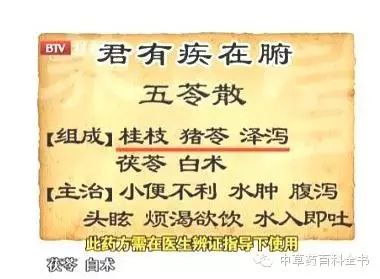
4、Wu Ling San (Five-Ingredient Powder with Poria)《Shang Han Lun》
Composition: Fu Ling (Poria) 9g, Zhu Ling (Polyporus) 9g, Ze Xie (Alisma) 12g, Bai Zhu (White Atractylodes) 9g, Gui Zhi (Cinnamon Twig) 6g.
Usage: Decoction in water.
Function: Promotes urination, drains dampness, strengthens the spleen, and transforms Qi.
Indications: Edema caused by internal dampness, diarrhea, difficulty urinating, as well as cough with clear thin phlegm, dizziness, and palpitations.
Formula Analysis: In this formula, Fu Ling, Zhu Ling, and Ze Xie are the main herbs for promoting urination and draining dampness; Bai Zhu strengthens the spleen and promotes the movement of dampness, enhancing the action of Fu Ling in draining dampness, serving as an adjunct herb; Gui Zhi warms Yang to assist the bladder in Qi transformation, allowing water to flow naturally. Together, these herbs can both promote urination to drain dampness and strengthen the spleen to move dampness, thus treating various symptoms caused by internal dampness.
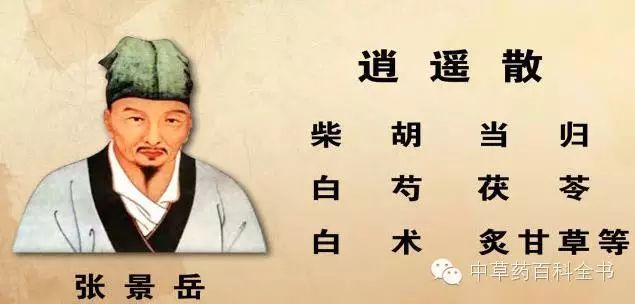

5、Xiao Yao San (Free and Easy Wanderer Powder)《Tai Ping Hui Min He Ji Ju Fang》
Composition: Chai Hu (Bupleurum) 12g, Bai Shao (White Peony) 12g, Dang Gui (Angelica) 12g, Fu Ling (Poria) 12g, Bai Zhu (White Atractylodes) 12g, Zhi Gan Cao (Honey-Fried Licorice) 6g.
Usage: Decoction in water. Alternatively, the above herbs can be ground into powder, with each dose being 6g, and boiled with a little ginger and mint, taken three times a day.
Function: Soothe the liver, nourish the blood, and strengthen the spleen.
Indications: Pain in the flanks, headache, dizziness, dry mouth and throat, fatigue, poor appetite, or irregular menstruation due to liver Qi stagnation and blood deficiency.
Formula Analysis: Chai Hu soothes the liver and relieves stagnation, while Dang Gui and Bai Shao nourish the blood and soften the liver. These three herbs work together as the main herbs in the formula; Bai Zhu and Fu Ling strengthen the spleen and harmonize the middle, serving as adjunct herbs; mint and ginger assist in the dispersing and regulating function of the formula; Zhi Gan Cao harmonizes the various herbs as the envoy herb. Together, these herbs relieve liver stagnation, nourish blood, and strengthen the spleen, leading to the resolution of symptoms.
Top Ten Famous TCM Formulas (Part Two)
【Encyclopedia of Chinese Herbal Medicine】 Here we have selected the top ten famous TCM formulas, organized into two parts for your reading and collection. This is the second part, including Xiao Qing Long Tang (Minor Blue Dragon Decoction) from “Shang Han Lun”, Da Cheng Qi Tang (Major Order the Qi Decoction) from “Shang Han Lun”, Xiao Chai Hu Tang (Minor Bupleurum Decoction) from “Shang Han Lun”, Wu Ling San (Five-Ingredient Powder with Poria) from “Shang Han Lun”, Xiao Yao San (Free and Easy Wanderer Powder) from “Tai Ping Hui Min He Ji Ju Fang”, Xue Fu Zhu Yu Tang (Blood Mansion Drive Out Stasis Decoction) from “Yi Lin Gai Cuo”, Bu Zhong Yi Qi Tang (Tonify the Middle and Augment the Qi Decoction) from “Pi Wei Lun”, Gui Pi Tang (Return the Spleen Decoction) from “Ji Sheng Fang”, Liu Wei Di Huang Wan (Six-Ingredient Pill with Rehmannia) from “Xiao Er Yao Zheng Zhi Jue”, and Wen Dan Tang (Warm the Gallbladder Decoction) from “San Yin Ji Yi Bing Zheng Fang Lun”.
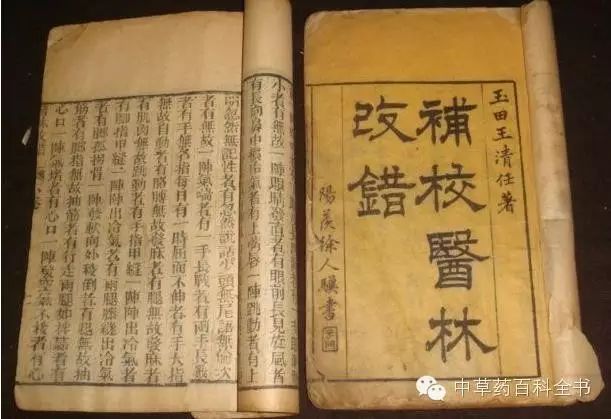
6、Xue Fu Zhu Yu Tang (Blood Mansion Drive Out Stasis Decoction)《Yi Lin Gai Cuo》
Composition: Dang Gui (Angelica) 9g, Sheng Di Huang (Raw Rehmannia) 9g, Tao Ren (Peach Kernel) 12g, Hong Hua (Safflower) 9g, Zhi Qiao (Bitter Orange) 6g, Chi Shao (Red Peony) 6g, Chuan Xiong (Chuanxiong) 5g, Chai Hu (Bupleurum) 3g, Jie Geng (Platycodon) 5g, Niu Xi (Achyranthes) 9g, Gan Cao (Licorice) 3g.
Usage: Decoction in water.
Function: Invigorates blood, dispels stasis, moves Qi, and alleviates pain.
Indications: Chest pain, headache, and persistent pain that feels like a needle prick, or prolonged hiccups, or internal heat and irritability, palpitations, and insomnia, with a dark red tongue and stasis spots or points, and a rough or wiry pulse.
Formula Analysis: In this formula, Tao Ren, Hong Hua, and Chuan Xiong are the main herbs for invigorating blood and dispelling stasis; Dang Gui and Chi Shao nourish and invigorate blood, while Niu Xi dispels stasis and promotes blood flow downward. These three herbs assist the main herbs in invigorating blood and dispelling stasis; Sheng Di Huang pairs with Dang Gui to nourish and harmonize blood, preventing the dispelling of stasis from harming Yin blood. Chai Hu, Zhi Qiao, and Jie Geng relieve Qi stagnation in the chest, treating Qi stagnation symptoms, and allowing Qi to move with blood. Gan Cao harmonizes the various herbs as the envoy. Together, these herbs promote blood circulation and resolve stasis-related symptoms.
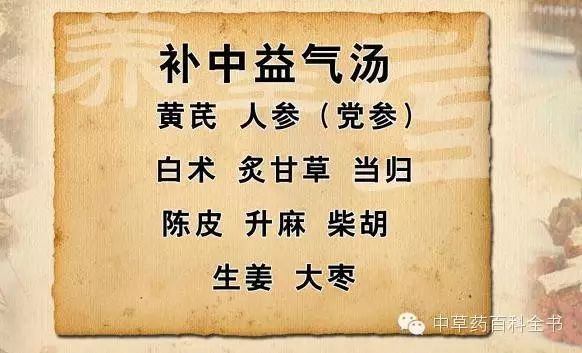 7、Bu Zhong Yi Qi Tang (Tonify the Middle and Augment the Qi Decoction)《Pi Wei Lun》
7、Bu Zhong Yi Qi Tang (Tonify the Middle and Augment the Qi Decoction)《Pi Wei Lun》
Composition: Huang Qi (Astragalus) 15g, Bai Zhu (White Atractylodes) 10g, Dang Shen (Codonopsis) 15g, Dang Gui (Angelica) 6g, Chen Pi (Aged Tangerine Peel) 6g, Chai Hu (Bupleurum) 5g, Sheng Ma (Cimicifuga) 5g, Zhi Gan Cao (Honey-Fried Licorice) 5g.
Function: Regulates and tonifies the spleen and stomach, augments Qi, and raises Yang.
Usage: Decoction in water.
Indications: Spleen and stomach Qi deficiency and sinking Qi. Symptoms include fatigue, poor appetite, loose stools, pale tongue, weak pulse, or heat with sweating, thirst for warm drinks, prolapse of the rectum, uterine prolapse, chronic diarrhea, and chronic malaria.
Formula Analysis: This formula is primarily used to treat spleen and stomach Qi deficiency and sinking Qi. Huang Qi is the main herb for tonifying the middle and augmenting Qi, raising Yang and securing the exterior; Dang Shen, Bai Zhu, and Zhi Gan Cao are warm and tonifying, benefiting the spleen and stomach as adjunct herbs; the spleen and stomach are the source of Qi and blood, and spleen deficiency can easily lead to Qi stagnation, so Chen Pi is used to regulate Qi and transform stagnation; Sheng Ma and Chai Hu work together with Huang Qi and Dang Shen to raise the Yang Qi; Qi deficiency can lead to blood deficiency, so Dang Gui is used to nourish blood and harmonize the Qi, serving as an envoy herb. Together, these herbs achieve the effects of tonifying the middle, augmenting Qi, raising Yang, and strengthening the spleen and stomach.
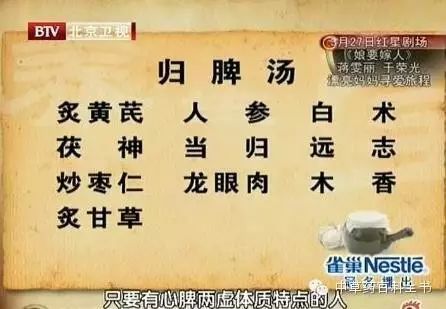
8、Gui Pi Tang (Return the Spleen Decoction)《Ji Sheng Fang》
Composition: Bai Zhu (White Atractylodes) 9g, Fu Shen (Poria) 10g, Huang Qi (Astragalus) 12g, Long Yan Rou (Longan Flesh) 10g, Suan Zao Ren (Sour Jujube Seed) 10g, Dang Shen (Codonopsis) 12g, Zhi Gan Cao (Honey-Fried Licorice) 5g, Dang Gui (Angelica) 10g, Yuan Zhi (Polygala) 10g, Mu Xiang (Aucklandia) 10g.
Usage: Add Sheng Jiang (Fresh Ginger) 6g and Da Zao (Jujube) 3 pieces, decoct in water.
Function: Strengthens the spleen, nourishes the heart, augments Qi, and replenishes blood.
Indications: (1) Heart and spleen deficiency with insufficient Qi and blood, leading to palpitations, forgetfulness, insomnia, poor appetite, fatigue, pale complexion, pale tongue, and weak pulse. (2) Spleen deficiency leading to irregular menstruation, excessive bleeding, and subcutaneous bleeding.
Formula Analysis: The formula is based on the Si Jun Zi Tang (Four Gentlemen Decoction) to tonify Qi and strengthen the spleen, ensuring that Qi and blood are produced; Dang Gui is used to nourish blood and promote blood production, serving as an adjunct herb; Long Yan Rou, Suan Zao Ren, and Yuan Zhi nourish the heart and calm the spirit, while Mu Xiang regulates Qi and awakens the spleen, ensuring that the tonifying effect does not stagnate. Sheng Jiang and Da Zao harmonize the nutritive and defensive Qi, serving as the envoy herb. Together, these herbs achieve the effects of tonifying Qi, strengthening the spleen, nourishing the heart, and replenishing blood.
9、Liu Wei Di Huang Wan (Six-Ingredient Pill with Rehmannia)《Xiao Er Yao Zheng Zhi Jue》
Composition: Shu Di Huang (Prepared Rehmannia) 240g, Shan Yao (Chinese Yam) 120g, Shan Zhu Yu (Cornus) 120g, Ze Xie (Alisma) 90g, Fu Ling (Poria) 90g, Dan Pi (Moutan) 90g.
Usage: Grind into powder, refine with honey into pills or decoct as a soup.
Function: Nourishes the liver and kidneys.
Indications: Liver and kidney Yin deficiency with empty heat rising, leading to soreness and weakness in the lower back and knees, dizziness, tinnitus, night sweats, nocturnal emissions, or tidal fever, heat in the palms and soles, thirst, toothache due to empty heat, dry tongue, red tongue with little coating, and thin rapid pulse.
Formula Analysis: In this formula, Shu Di Huang nourishes the kidneys and replenishes essence as the main herb; Shan Yao strengthens the spleen and secures essence, while Shan Zhu Yu nourishes the liver and astringes essence, forming the three tonifying herbs. Ze Xie clears kidney fire, preventing Shu Di Huang from being too cloying; Fu Ling drains dampness to assist Shan Yao in promoting movement, while Dan Pi clears liver fire and moderates the warming nature of Shan Zhu Yu, forming the three draining herbs. Together, these six herbs balance tonification and drainage, complementing each other to achieve the effect of nourishing the liver and kidneys.
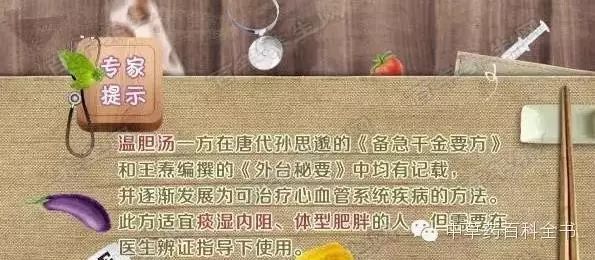
10、Wen Dan Tang (Warm the Gallbladder Decoction)《San Yin Ji Yi Bing Zheng Fang Lun》
Composition: Ban Xia (Pinellia) 6g, Zhu Ru (Bamboo Shavings) 6g, Zhi Shi (Bitter Orange) 6g, Chen Pi (Aged Tangerine Peel) 9g, Gan Cao (Licorice) 3g, Fu Ling (Poria) 5g, Sheng Jiang (Fresh Ginger) 3g, Da Zao (Jujube) 3g.
Usage: Decoction in water.
Function: Regulates Qi, transforms phlegm, clears the gallbladder, and harmonizes the stomach.
Indications: Disharmony between the gallbladder and stomach, with phlegm-heat disturbing. Symptoms include irritability and insomnia, or vomiting and hiccups, as well as palpitations and restlessness, with dark yellow tongue and phlegm-heat signs.
Formula Analysis: In this formula, Ban Xia is the chief herb, descending Qi and harmonizing the stomach, drying dampness and transforming phlegm. Zhu Ru is the minister herb, clearing heat and transforming phlegm, stopping vomiting and alleviating irritability; Zhi Shi regulates Qi and transforms phlegm, allowing phlegm to descend with Qi. Chen Pi regulates Qi and dries dampness, while Fu Ling strengthens the spleen and drains dampness, facilitating the removal of phlegm. Ginger, dates, and licorice benefit the spleen and harmonize the stomach, coordinating the various herbs. Together, these herbs achieve the effects of regulating Qi, transforming phlegm, clearing the gallbladder, and harmonizing the stomach.
Disclaimer This article is copyrighted by the original author. Please indicate the source when reprinting. We share this article for the purpose of dissemination and learning exchange, and do not take responsibility for the views expressed in the article. If there are any copyright issues, please contact us for removal.

